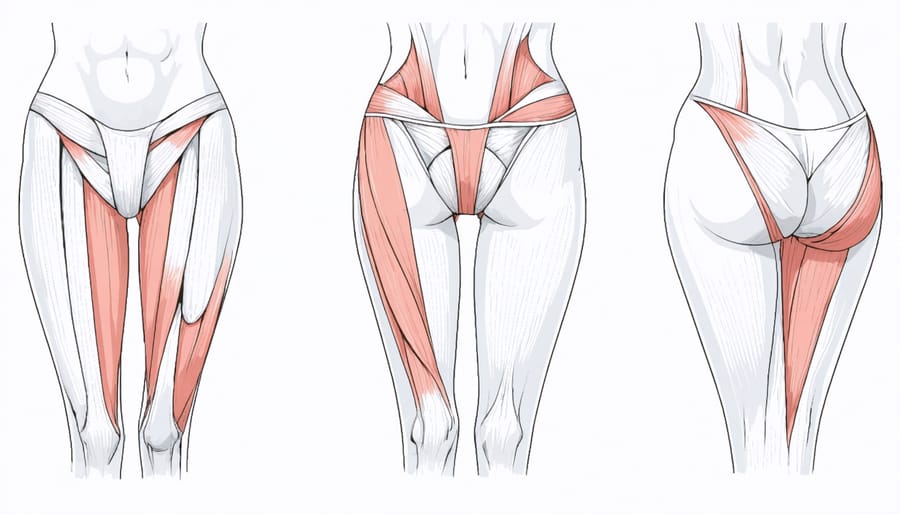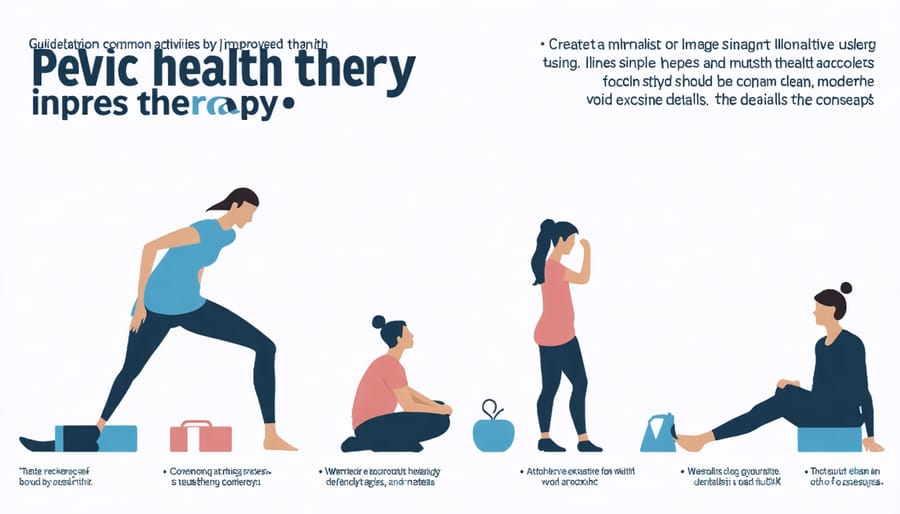Discover the transformative power of pelvic health physical therapy, a specialized healthcare approach helping thousands of Canadians reclaim their health and vitality. This evidence-based treatment addresses core issues affecting daily comfort, physical function, and overall well-being – from bladder control to chronic pain management.
Beyond traditional physical therapy, pelvic health specialists employ targeted exercises, manual therapy, and behavioral techniques to strengthen and rehabilitate the pelvic floor muscles. These crucial muscles support vital organs, maintain continence, and play a key role in sexual function. Whether recovering from childbirth, managing chronic conditions, or seeking preventive care, this specialized therapy offers personalized solutions for optimal pelvic health.
Research shows that over 60% of individuals experiencing pelvic floor dysfunction can significantly improve their symptoms through dedicated physical therapy intervention. With proper assessment and treatment, patients often report enhanced quality of life, improved physical function, and renewed confidence in their daily activities.

Understanding Your Pelvic Floor: The Foundation of Women’s Health
Key Functions of Your Pelvic Floor
Your pelvic floor muscles play a vital role in supporting multiple essential bodily functions. These muscles form a hammock-like structure at the base of your pelvis, working together to maintain control over bladder and bowel movements, support internal organs, and contribute to sexual function.
One of the primary functions is maintaining continence by controlling the opening and closing of the urethra and rectum. When functioning properly, these muscles help prevent unwanted leakage and allow you to delay bathroom visits until appropriate times.
The pelvic floor also provides crucial support for your internal organs, including the bladder, uterus (in women), and rectum. Think of it as a natural support system that helps keep everything in its proper place and prevents organ prolapse.
During pregnancy and childbirth, these muscles play an especially important role. They help support the growing baby and assist during delivery. The pelvic floor also contributes to core stability, working with your abdominal and back muscles to maintain good posture and support your spine.
Additionally, healthy pelvic floor muscles are essential for sexual function, helping to enhance sensation and maintain erectile function in men and contributing to arousal and orgasm in women.
Common Signs of Pelvic Floor Dysfunction
Recognizing the signs of pelvic floor dysfunction is crucial for seeking timely care. Common symptoms include frequent urination or a sudden, strong urge to urinate, even with an empty bladder. You might experience difficulty starting or stopping your urine stream, or notice occasional leakage when coughing, laughing, or exercising.
Lower back pain that doesn’t improve with regular treatment could indicate pelvic floor issues. Some people report feeling pressure or heaviness in their pelvic region, particularly when standing for long periods. Discomfort during intimate activities is another important sign that shouldn’t be ignored.
For those who’ve given birth, a sensation of vaginal heaviness or bulging might occur. Men may experience difficulty with bladder control or persistent pain in the pelvic region. Both men and women might notice constipation or straining during bowel movements that doesn’t resolve with dietary changes.
Remember that these symptoms can vary in severity and combination. If you’re experiencing any of these signs, consulting a healthcare provider can help determine if pelvic floor physical therapy might be beneficial for you.
How Pelvic Health Physical Therapy Works
What to Expect in Your First Session
Your first pelvic health physical therapy session typically lasts 45-60 minutes and begins with a thorough discussion of your health history and current concerns. Your therapist will ask about symptoms, lifestyle factors, and your personal goals for treatment in a comfortable, private setting.
The physical assessment usually includes examining your posture, breathing patterns, and how you move. Your therapist will assess muscle strength and coordination in your core, hips, and pelvic floor. They may also check for any tissue restrictions or areas of tension that could be contributing to your symptoms.
With your consent, an internal examination might be recommended to evaluate pelvic floor muscle function. This is completely optional, and your therapist will clearly explain the process and ensure you’re comfortable before proceeding. You’ll remain partially clothed and draped throughout the examination.
Based on the assessment findings, your therapist will develop a personalized treatment plan and discuss it with you. This typically includes a combination of exercises, stretches, and other techniques you can practice at home. They’ll also address any questions or concerns you might have about your condition and treatment goals.
Remember, you’re in control of your session. Feel free to ask questions or express any concerns at any time. Your comfort and understanding of the process are top priorities for your healthcare team.
Treatment Techniques and Exercises
Pelvic health physical therapy employs a variety of effective treatment techniques tailored to each patient’s specific needs. Common approaches include gentle manual therapy, where therapists use specialized hands-on techniques to release tight muscles and improve tissue mobility. Biofeedback training helps patients better understand and control their pelvic floor muscles using sensors that provide visual or audio feedback.
Therapeutic exercises form a crucial part of treatment and can be performed both in the clinic and at home. These typically include:
– Pelvic floor muscle training (Kegel exercises)
– Breathing exercises coordinated with pelvic floor movement
– Gentle stretching for hip and lower back muscles
– Core strengthening exercises
– Relaxation techniques
Your therapist might also incorporate tools like pressure biofeedback devices or vaginal dilators when appropriate. They’ll teach you proper posture and body mechanics to support pelvic health during daily activities.
For home practice, patients usually receive a personalized exercise program. Starting with 5-10 minutes daily, these exercises can include:
– Gentle bridge poses
– Cat-cow stretches
– Pelvic tilts
– Deep breathing exercises
– Mindful relaxation
Remember to perform all exercises as instructed by your therapist, and never push through pain. Consistency with your home program, combined with regular therapy sessions, typically yields the best results. Your therapist will adjust your treatment plan as you progress to ensure optimal outcomes.

Benefits Beyond the Obvious

Physical Benefits
Pelvic health physical therapy offers significant improvements in physical function and comfort for many individuals. Through targeted exercises and specialized techniques, patients often experience reduced pelvic pain and discomfort during daily activities. Many people report better bladder and bowel control, improved sexual function, and enhanced core stability.
The therapy helps strengthen pelvic floor muscles, which can alleviate symptoms of incontinence and reduce the frequency of bathroom visits. For those experiencing pelvic organ prolapse, the treatment can help manage symptoms and prevent condition progression. Pregnant and postpartum individuals often find relief from common discomforts and faster recovery after childbirth.
Regular sessions can also improve posture and reduce lower back pain by addressing muscle imbalances in the pelvic region. Athletes may notice enhanced performance and reduced risk of injury through better pelvic stability. The physical benefits extend beyond the pelvic area, contributing to overall mobility, flexibility, and functional movement patterns in everyday life.
By addressing underlying physical issues, this therapy helps patients return to activities they love with greater confidence and comfort.
Quality of Life Improvements
Pelvic health physical therapy can significantly enhance your daily life in numerous ways. Beyond the physical improvements, many patients report substantial benefits to their emotional well-being and overall quality of life. Patients often experience renewed confidence in social situations, improved sleep patterns, and greater comfort during daily activities.
Many individuals find they can return to activities they previously avoided, such as exercise, intimate relationships, or even simple tasks like sitting through a movie. The ability to manage bladder and bowel functions more effectively reduces anxiety about finding washrooms when out in public, leading to more spontaneous and enjoyable social experiences.
For new parents, pelvic health therapy can ease the transition back to regular activities post-pregnancy. Workers who spend long hours sitting or standing report better posture and reduced discomfort throughout their workday. Athletes often notice improved performance and stability during their training sessions.
These improvements contribute to a more active, confident, and fulfilling lifestyle, allowing you to focus on what matters most rather than managing discomfort or limitations.
When to Seek Pelvic Health Physical Therapy
Recognizing when to seek pelvic health physical therapy is crucial for maintaining optimal health and preventing long-term complications. While these services can be beneficial at any life stage, certain signs and symptoms warrant prompt attention from a pelvic health specialist.
If you experience ongoing pelvic pain, difficulty with bladder or bowel control, or discomfort during daily activities, it’s time to consider professional help. Pregnant individuals and those who have recently given birth should consider pelvic health therapy as part of their essential health screenings and postpartum care plan.
Other indicators include:
– Persistent lower back pain that doesn’t improve with general treatment
– Pain or pressure in the pelvic region
– Difficulty with sexual activity
– Feelings of heaviness or dropping in the pelvic area
– Leaking urine when coughing, laughing, or exercising
– Constipation or difficulty emptying the bowels
– Pain while sitting for extended periods
Don’t wait until symptoms become severe to seek help. Early intervention often leads to better outcomes and faster recovery. It’s particularly important to consult a pelvic health physical therapist if you’re:
– Planning pregnancy or currently pregnant
– Recovering from childbirth
– Approaching or experiencing menopause
– Preparing for or recovering from pelvic surgery
– Experiencing chronic pelvic pain
– Dealing with sports-related pelvic issues
Remember, pelvic health concerns are common but not normal, and help is available. Many people achieve significant improvement through targeted physical therapy intervention.
Finding the Right Pelvic Health Specialist in Canada
Finding a qualified pelvic health specialist in Canada requires careful consideration to ensure you receive the best possible care. Start by seeking recommendations from your family doctor or healthcare provider, who can refer you to registered physiotherapists specializing in pelvic health. These specialists are particularly experienced in addressing various women’s health concerns and pelvic conditions.
When searching for a specialist, verify their credentials through your provincial college of physiotherapists. Look for practitioners who have completed post-graduate training in pelvic health and maintain current registration with their regulatory body. Many qualified specialists will list their specific certifications and areas of expertise on their clinic websites or professional profiles.
Consider practical factors such as clinic location, appointment availability, and whether the specialist’s services are covered by your insurance or provincial health plan. Many clinics offer initial consultations where you can discuss your concerns and determine if the practitioner is the right fit for your needs.
Don’t hesitate to ask potential providers about their experience treating your specific condition, their treatment approach, and what to expect during sessions. A good pelvic health specialist should make you feel comfortable, answer your questions clearly, and create a treatment plan tailored to your goals.
Resources for finding qualified practitioners include:
– The Canadian Physiotherapy Association’s directory
– Provincial physiotherapy regulatory bodies
– Healthcare provider referral networks
– Specialized pelvic health clinics
Remember that you may need to try a few different specialists before finding the right match for your needs and comfort level.
Taking care of your pelvic health is an essential part of overall wellness that shouldn’t be overlooked. Whether you’re experiencing discomfort, recovering from childbirth, or simply wanting to maintain optimal pelvic health, physical therapy offers evidence-based solutions for better quality of life. Remember that pelvic health issues are common and treatable – there’s no need to suffer in silence. By working with qualified pelvic health physiotherapists, you can develop personalized strategies to strengthen your pelvic floor, improve function, and prevent future problems. Don’t wait for symptoms to worsen before seeking help. Take the first step toward better pelvic health by consulting with a healthcare provider about physical therapy options available in your community. Your future self will thank you for making this investment in your wellbeing.

